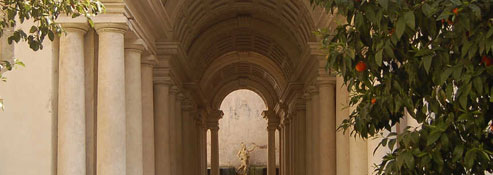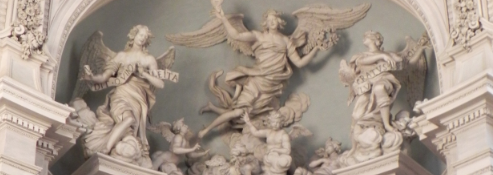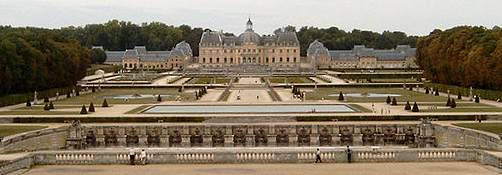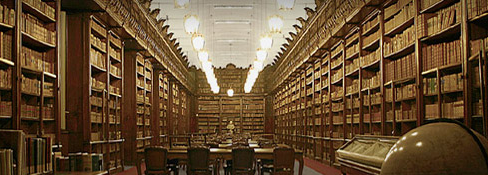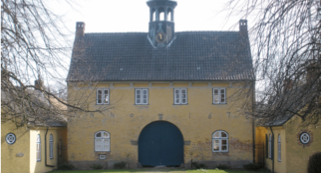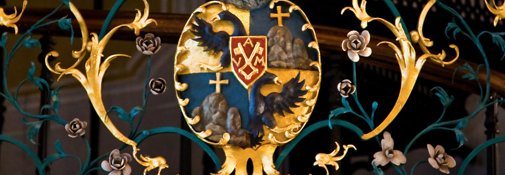In historiography, the Sixteenth century is well known as the « century of the secretary » - humanist secretaries - which means two statements :
1. that at Renaissance the function of secretary became a key function in the system of European states, as close councillor of the prince
2. that secretary became at the same time a strategic place - a discursive place - for political thought. The figure of secretary would have been the support of crucial reflections about both the art of being a ruler and the art of being a good councillor. In historiography, the secretary became an essential part of baroque politics, ruled by the secret. The close but non-institutionalized relationship between the secretary and his master would symbolize this typical art of secret. [1]
However, the historiographical theme of the "century of the secretaries" poses several problems. The first one and certainly not least: it mainly resumed the discourse presented in the treaties as if they were comprehensive pools of descriptions of a political and social phenomenon. This first problem is tightly related to the second which is the absence of works on the "century of the secretaries", of analysis of the gesture consisting in writing and publishing treaties dealing with secretary. What did it mean writing on such a subject? Studies easily look forward confronting the social situations of treaties' authors - most often secretaries - and the descriptions of the secretary function as it was presented in such books, without never integrating any theorizing approach to the subject to be analyzed.
The historiography of the « century of secretaries » is mainly based upon a body of twelve treaties (totalizing 40 editions) about secretary which were published between 1564 and 1630 in Italy. This is really a massive body - which one cannot be found in France. This mixed picture led either to assimilate the situation of French secretaries to the Italian one, or, on the contrary, to contrast the situation in both countries : in this case French secretaries seem not well considered in France in comparison with Italian secretaries. [2]
However, a French body of writings about secretary does exist in Renaissance France, but it remains quite invisible, because these writings did not appear as autonomous treatise. There is not a single French book the title of which would be "Du secrétaire", following the model of "Del segretario" -, except one translation. So this is not a body of books, but a body of treatise or reflections included into books of different purposes. As a whole: five books edited between 1555 and 1605.
Theorization of the function of secretary in 16th-century books
1555 François de Billon, Le Fort inexpugnable de l'honneur féminin […], Paris, Jean d'Allyer.
1569 Etienne du Tronchet, Lettres missives et familières d'Etienne Du Tronchet, Paris, Lucas Breyer.
1572 Etienne du Tronchet, Finances et thresor de la plume françoise […], Paris, Nicolas Duchemin.
1578 Jean Papon, Secrets du troisième et dernier notaire…, Lyon, Jean de Tournes.
1588 Gabriel Chappuys, L'art des secrétaires et nobles parties et qualitez d'iceux, Avec le Stile & methode fort facile d'escrire en tous genres de lettres missives…, Paris, Abel l'Angelier (d'après Sansovino, Del Segretario, 1564)
1605 Antoine de Laval, Desseins des professions nobles et publiques […], Paris, 1605.
Three of them come from a single area in France, the Forez, in the Massif Central, not far from Lyon - an area well known in the Seventeenth century as the country of Astrée, the best-seller by Honoré d'Urfé. Such focus is amazing. It leads to ask again the question about the links between French and Italian theories about secretary, because the Forez was for many reasons related to Italy.
But our purpose here is not to explain this amazing localization of French treatises. This localization is a fact, and this fact is our starting point, because it shows that the very production of such treatises was "located". In other words, this localization denaturalized the gesture which consisted in making a theory about secretary. As a consequence, these discourses can easily be included in something like "the political thought of Renaissance". This localization invites to enlarge the context allowing to understand the production and use of such a theory.
In this article, I would like to focus on the observation of this gesture. What does it mean writing and publishing about secretary in Renaissance France? This question requires to consider three things all together: the issue of secretary as a figure of a discourse, the social situation of Renaissance secretaries and the political practices related to this function.
I - The Forez and Italy
Let's begin with some words about the Forez and Italy, because, as I already said, three out of the five authors who wrote about the secretary came from the Forez. [3]
The first one was Etienne du Tronchet (about 1510- about 1580). He was born in Montbrison, in the core of the Forez, and lived at this place large most of his life. He published two collections of letters; both included an introduction dedicated to the function of secretary. [4] Du Tronchet was well known from Jean Papon, "lieutenant general en Forez", the main royal judge of the province, also a jurist. The second volume of his masterpiece, Les Trois Notaires, contains a treaty about secretary. [5] Finally, Antoine de Laval, author of the most important reflection of the secretary in his treaty Dessein des professions nobles et publiques, published in 1605, was born in a village of Forez, and moved not far from this province: he made his residence in Bourbonnais, at the city of Moulins les Allier. [6]
The historian of Forez Litterature, Claude Longeon, expounded the grounds of the links between Forez and Italy for a long time. [7] Forez is not far from Lyon, where lived numerous Italian merchants and bankers. Further, Forez nobility had a long tradition to serve in Savoie, which was not far either from Forez. There were also relationships between Forez intellectuals and other French Italianists scholars. So our three authors could have been familiar with texts and political practices from Italy.
The two other authors were also linked with Italy. François de Billon was a secretary of the duc of Parma when he published Le Fort inexpugnable de l'honneur feminin during a stay in Paris for the service of his master. [8] Gabriel Chappuys, born in Touraine, made a long trip in Italy when he was a young man. [9] Next he lived in Savoie, before moving to Lyon to seek protection from rich Italian merchants of this city. In Lyon, he became well known as a professional translator. Then he moved to Paris. Among many publications, he translated the first Italian treaty, Del Segretario by Francesco Sansovino, but brought deep transformations from the original. [10]
So we can see that the secretary is an Italian subject. To deal with this subject required familiarity with Italian culture. In return, publishing about secretary enlightened some skill of the Italian culture. This skill could have been transmitted by Italians living in France. The Billon's book was dedicated to Catherine de Médicis, whereas the Lettres missives, due to Du Tronchet, were addressed to Albert de Gondi, duke of Retz, well-known political figure at the French court in the 1570s'.
But the aim of these reflections isn't to give knowledge about Italy. These reflections focus above all on secretary in France. Italy works as an intellectual place relevant to think the function of secretary in France.
II - The French secretaries of the King
It's a commonplace in the treaties del segretario - French and Italian - to elaborate at length the distinction between true and false secretaries. What was a true secretary in France? He was the one who drafted the letters of a king, a prince, in any case a great man with public fonctions. All the others had to be called "scribes". [11]
Their discourse focalized on one specific function: secrétaire du roi. [12] The secretaries of the king held the monopoly of the expedition of the royal decisions produced in the royal chancelleries. The "secretaires du roi" had to sign, and by this means authenticate, royal acts. But many of them didn't mainly work in the chancellery: the King charged them with various missions by the king, especially in the field of royal finances.
"Secrétaire du roi" was a royal office which could be bought and sold, and which was quite expensive: so, owning one of these offices meant belonging to the first circle of the administrative staff of the monarchy. And this office provided its owner with important privileges, especially: it conferred nobility after twenty years of service.
In the second half of the Sixteenth century, the number of secretaries of king increased hardly: from about 120 to 200 under Henri III. To complete the picture, the case of the secretaries of State must be added. In 1547, for the first time, four "secretaires d'Etat" emerged among the "secretaires du roi". They had to sign the decisions concerning royal finances and the acts ordered by the king himself.
All this means that in the second half of the Sixteenth century all the attention was turned toward this function. To some extent, secretary became an attractive and even fashionable function. It became a valuable topic for writing, a relevantsubject to be dealt with and used. And the contact with Italy was considered as a legitimizing way to write about secretary.
III - Writing about secretaries
No single secretary of the king can be found among our writers who were of a lower social condition. Two of them, Billon and Du Tronchet were particular secretaries without the insurance given by the office of secretary of the king. Antoine de Laval was a little officer with uncertain social status. He claimed in his book that he had close relationships with important figures of ministers under Henri III et Henri IV, but it cannot be find out whether all the letters and treatises addressed to theses figures meant that he knew them or either did he use these discourses to try to enter in relationship with them. Gabriel Chappuys worked mainly for editors, and his translation of Sansovino was dedicated to a secretary of the king.
In fact, these books seem to have been instruments to find a good place or a form of recognition by monarchy. Our writers couldn't hope to receive any office of "secretaire du roi", because none of them wasn't rich enough or sufficiently introduced among the network of royal officers. Du Tronchet for instance presented very clearly his first book as part of an operation to get a situation as a domestic secretary in the Catherine de Medicis' household. This book, les Lettres familières d'Estienne du Tronchet, stated his effective job-search strategy: a request to the queen, letters to different courtiers so as they act as brokers for him show Du Tronchet mastery of court's social and epistolary codes. The whole collection of his letters reveals both his art in writing letters as well as the great extension of his social network, from the officers in Forez to the court, including a wide variety of people from Lyon and Paris.
Further, our authors stated their good knowledge of royal administration. For example, François de Billon used the right titulature to distinguish within the chancellery the new "secretaires des commandemens de la Maison de france", a function very recently promoted by Henri II, and Billon gave the name of these four new secretaries. [13] Our writers did act as wise and experienced observers of the power.
This experience could lead them to criticize political practices. But significantly, Jean Papon, who was not seeking any employment, and whose social status was superior to the other writers', was the only one to do so. In his treaty, he considered the functioning of power from the question of the production and circulation of official acts - a question involving especially the secretaries. Papon offered us a very original point of view on the process of transformation of the prince's order into an official document. And he pointed very accurately several dysfunctions in this process.
Papon explained at the beginning of his book that he is retired from the court since many years. However his reflection can be seen as a way for having a grip on the court, from the Forez. His retirement is a component of the figure he stated through this book: a wise man who observes the court from a distance. And such a figure could be valuable in the relationship of power in which Papon was involved, in Forez and elsewhere.
IV - Action with books
Up to now, I stressed that the reflections about secretaries were actions - maybe precisely addressed in a specific context. However this action is an action with books. It implies that the action can be renewed, started again, and multiplied, for example by giving the book as a gift to a new potential master. The book gave a reputation which could be useful in several circumstances.
A second consequence of acting with books can be seen with the case of Etienne du Tronchet. He published his collection of letters after a long carrier, however his book engaged him in a new career : a career of author. After 1569, he found a new job as secretary - secretary of a French ambassador in Italy - but he also published several books. And in his second collection of letters, his discourse about the function of secretary changes a bit. This book his a letter-writing manual, addressed to "les secretaires de France". Hence the distinction between true and false secretaries vanished and was replaced by a large address to all who could make a professional use of his book.
Of course we can interpret these treatises in terms of a political culture typical of the baroque age. But the gesture, which consisted to publish about the secretary, reflects less a culture of secret, for example, or the growing sophistication of political practices, than a desire of a whole staff of professional of Letters to find safe places in the state or the aristocratic or ministerial households. [14] And this personnel used books as instruments to pursue this goal. In our understanding of the conjuncture of the baroque age, we have to include the possibility of acting with books. [15]
Notes
1. Lina Bolzoni, Il segretario neoplatonico, in Adriano Prosperi (éd.), La Corte e il « Corteggiano », vol. II (Un modello Europeo), Rome, 1980, p. 133-169; Adelin Charles Fiorato, « Grandeur et servitude du secrétaire: du savoir théorique à la collaboration politique », in Culture et professions en Italie (XVe-XVIIe siècles), Etudes réunies par Adelin Charles Fiorato, Paris, Publications de la Sorbonne, 1089, p. 133-184; Salvatore Nigro, « Il Segretario », in Rosario Villari (éd.), L'Uomo barocco, Rome, Laterza, 1991; Jean-Pierre Cavaillé, Dis/simulations. Jules-César Vanini, François La Mothe Le Vayer, Gabriel Naudé, Louis Machon et Torquato Acetto. Religion, morale et politique au XVIIe siècle, Paris, Champion, 2002, p. 335-339 ; Douglas Biow, Doctors, Ambassadors, Secretaries, Humanism and Professions in Renaissance Italy, Chicago and London, The Chicago University Press, 2002; Rosanna Gorris Camos (éd.), « Il segretario è come un angelo ». Trattati, raccolte epistolari, vite paradigmatiche, ovvero come essere un buon segretario nel Rinascimento, Atti del XIV Convegno Internazionle di Studio Verona, 25-27 maggio 2006, Fasano, Schena Editore, 2008.
2. For the first attitude, see for example Franck Lestringant, Clément Marot. De l'adolescence à l'enfer, 2e éd., Orléans, paradigme, 2009, p. 148-149 ; as for the second, see Marc Bizer, Les Lettres romaines de Du Bellay. Les Regrets et la tradition épistolaire, Montréal, Presses de l'Université de Montréal, 2001, p. 51-52.
3. Claude Longeon, Les écrivains foréziens du XVIe siècle, Répertoire bio-bibliographique, Centre d'études foréziennes, 1970 ; Ibid., Une province française à la Renaissance La vie intellectuelle en Forez au XVIe siècle, Centre d'études foréziennes, 1975. Most bio-bibliographical information come from these two books.
4. Lettres missives et familières d'Estienne Du Tronchet, secrétaire de la Royne mère du Roy. A Messire Albert de Gondy, Conte doyen Baron de Rectz, Paris, Lucas Breyer, 1569 ; Finances et thresor de la plume françoise de Estienne du Tronchet, Secretaire de la Royne, Paris, Nicolas du Chemin, 1572.
5. Instrument du premier notaire de Iean Papon, Conseiller du Roy, & lieutenant general au Bailliage de Forests, Lyon, Jean de Tournes, 1576 ; Trias judiciel du second notaire de jean papon conseiller du roy et lieutenant general au Bailliage de Forestz, Lyon, Jean de Tournes, imprimeur du roy, 1575 ; Secrets du troisième et dernier notaire de Jean Papon, Conseiller du Roy, & Lieutenant général au Bailliage de Forests, Lyon, Jean de Tournes, 1678. On Jean Papon, see Claude Longeon, Ecrivains foreziens.., op. cit., p. 35-58 ; Claude Longeon, Une province française à la Renaissance…, op. cit., passim ; Evelyne Berriot-salvadore, « L'illustration d'une bourgeoise sagesse : les Arrests notables de Jean Papon », in Gabriel-André Pérouse (éd.), Etudes sur Etienne Dolet (…) publiées à la mémoire de Claude Longeon, Genêve, Droz, 1993, p. 201-212
6. Desseins de professions nobles et publiques Conbtenans plusieurs Traités divers & rares : Avec l'histoire de la Maison de Bourbon. Iadie dediez au feu roi Henry IIII et maintenant au Tres-Chrétien & Tres-puissant Roy de France & de Navarre Louis XIII. Autrefois proposés an forme de Leçons paternelles, pour Avis & Conseil des Chemins du Monde. Par Anthoine de Laval, Geographe du Roy, Capitaine de son Parc & Château lés Moulins en Bourbonnois. A son fils. De nouveau reveu corrigé & augmenté des Problemes Politiques, avec une Table bien particuliere pour tout le cors de l'œuvre, Paris, Veuve Abel l'Angelier, [1605], 2nd édition, 1612. About Antoine de Laval, see Claude Longeon, Ecrivains foréziens…, op. cit., p. 390-403 ; Jacques Lavaud, Un Poète de cour au temps de Valois : Philippe Desportes (1546-1606), Paris, Droz, 1936, p. 97-98 ; H. Faure, Antoine de Laval et les écrivains bourbonnais de son temps, Moulins, chez Martial Place, libraire-éditeur, 1870, 2e éd.; « L'œuvre cartographique de Nicolas de Nicolay et d'Antoine de Laval (1544-1619) by M.R. Hervé, Bulletin de la Section de Géographie du comité des Trav. Hist. Et scientifiques, 1955, 1956, p. 223-263 ; Jean Boutier, Alain Dewerpe, Daniel Nordman, Un tour de France royal. Le voyage de Charles IX (1564-1566), Aubier, 1984, p. 50-54.
7. Claude Longeon, Une province française…, op. cit., p. 364-405.
8. François de Billon, Le Fort inexpugnable de l'honneur du sexe féminin, Paris, Jean d'Allyer, 1555. On Billon, see the introduction of the new edition to his book by M.A. Creech and D. Litt (S.R. Publishers LTD, Johnson Reprint Corporation, Mouton Editeur, 1970).
9. Gabriel Chappuys, L'art des secrétaires et nobles parties et qualitez d'iceux, Avec le Stile & methode fort facile d'escrire en tous genres de lettres missives : la declaration de chacune des parties d'icelles, illustrees d'exemples, pour l'instruction de ceux qui veulent apprendre à composer plusieurs belles, parfaictes & doctes Epistres, pour le profit & contentement de tous ceux qui suivent un art tant noble, extraites d'hommes sçavants. Par G.C.T Historiographe du Roy, Paris, Abel l'Angelier, 1588. On that book and his author, see: L'Art des Secretaires (1588), édited by Patrick Mula, Filigrana, n°6, 2000-2001, II, p. 17-283 ; Patrizia De Capitani, « Un traducteur français de textes italiens à la fin de la Renaissance, Gabriel Chappuys (env. 1546-env. 1613), Filigrana n°6, I, p. 89-114 ; Patrick Mula, « De Venise à Paris. L'Art des Secretaires de Gabriel Chappuys entre traduction et création », Filigrana n°6, I, p. 115-182.
10. Francesco Sansovino, Del Secretario… Libri IV, Venetia, Rampazzato, 1564.
11. See, for instance, Anthoine de Laval : « I'appelle secretaire celuy auquel le Prince Souverain, ou celuy qui le represante, commet la charge de declarer son intention par escrit en toutes sortes d'affaires de son estat secretes ou publiques. Ceste definition ou description du Secretaire ne peut pas convenir à ceux qui servent les particuliers en leurs affaires domestiques & privées, ce que feu M. le Connestable Anne de Montmorency, montra bien a celuy qui luy amena un de ses serviteurs lors qu'il commanda qu'on luy fit venir un Secrétaire : disant que celuy qu'on luy avoit amené n'estoit rien qu'un clerc, ou un homme escrivant pour luy : qu'il n'y avoit que le Roy qui eut des secretaires. […] Aussi à dire vray, & pour parler rondement, en tout ce qui part de la main des autres que des Secretaires du Roy, n'y a pas un mot d'Estat… » (Desseins…, op. cit., f°199 v.)
12. Hélène Michaud, La grande chancellerie et les écritures royales au XVIe siècle (1515-1589), Paris, PUF, 1967, p. 118-126. See also Sylvie Charton-Le Clech, Chancellerie et culture au XVIe siècle (les notaires et secrétaires du roi de 1515 à 1547), Toulouse, Presses universitaires du Mirail, 1993.
13. François de Billon, Le Fort inexpugnable…, op. cit., f° 240 r.v.
14. Roger Chartier, « Espace social et imaginaire social : les intellectuels frustrés au XVIIe siècle », Annales ESC, mars-avril 1982, p. 389-400.
15. Dinah Ribard et Nicolas Schapira, « Histoire du livre, histoire par le livre », Revue de Synthèse, Sixième série, tome 128, n°1-2 2007, "L'histoire par le livre, XVIe-XXe siècle", p. 19-25.



